Once again we Indians have no choice but to support other nations in the FIFA World Cup. Almost everyone of you must be wondering when will our national team finally play in the biggest stage of the game. The sooner we find an answer to the question the better it is but for now Goal.com lists ten Indian connections with the competition so that you don't feel that India is entirely left out.
The connections are not in any particular order
The connections are not in any particular order
INDIA AT FIFA World Cup Qualification
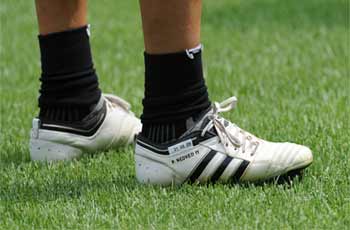
No Shoes, No World Cup
India first entered for the qualifying competition during the 1950 edition which was held in Brazil. There were four entries from Asia - Burma, Indonesia, Philippines and India. Burma, Indonesia and Philippines withdrew from the qualifying competition which gave India automatic entry into the final rounds of the tournament where they were set to meet Italy, Paraguay and Sweden.
However Indian players wanted to play barefoot since they had been playing in that fashion during that period but a FIFA ruling didn't allow teams to play barefoot thus forcing India to withdraw. India lost their chance of playing in the main rounds of the FIFA World Cup and till date they haven't been anywhere near qualifying.

Vikash Dhorasoo
Vikash Dhorasoo
Vikash Dhorasoo was born in Harfleur, France but is actually of Indo-Mauritian origin belonging to the Telugu community. He started his professional career with Le Havre but his best spell was at Lyon where he spent five seasons and won two French league titles with them. Dhorasoo also spent one season at Italian giants AC Milan, with whom he won a Champions league runners-up medal in 2005.
He made his international debut for France in 1999 but his only World cup was the 2006 edition where he made two substitute appearances. That was his last tournament at international level after which he retired.
Komaleeswaran Shankar
Referee Komaleeswaran Shankar made history in the 2002 World Cup as he became the first Indian to officiate in a World Cup match. Shankar was one of the assistant referees in a Group G encounter between Croatia and Mexico which the latter won 1-0.
The match was played at the Niigata Stadium, Niigata in Japan and just before the start of the game Shankar was seen shedding tears of joy on realizing the feat he had achieved. The 46 year old Indian Bank employee from Chennai has officiated in some of the biggest games of the country and many major Asian competitions at club and international level. But 3rd June, 2002 will definitely go down as the greatest day of his career as he got to officiate in the biggest stage of the game.
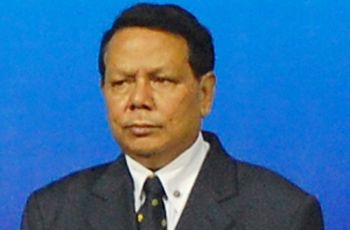
Match Commissioner
Priya Ranjan Dasmunshi
Former AIFF President Mr Priya Ranjan Dasmunshi, who is currently in a coma following a heart attack, made India proud in the 2006 FIFA World Cup by officiating as match commissioner for two group stage matches. Mr. Das Munshi became the first Indian to be given such an honour by FIFA. A match commissioner is FIFA's official representative in the match and his job is to ensure that the match is properly organized and run smoothly.
Mr. Das Munshi first officiated in a Group H encounter between Spain and Tunisia which the European nation won 3-1. Then the former union minister oversaw the Group F Croatia – Australia game which ended in a 2-2 stalemate but will be best remembered for English referee Graham Poll's mistake of sending off Croatian defender Joseph Simunic after showing him three yellow cards. Both matches were played at Stuttgart's Gottlieb-Daimler-Stadion.
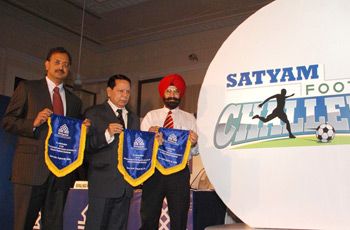
Official Sponsors
Mahindra Satyam
Mahindra Satyam is the official information technology service provider for the 2010 FIFA World Cup. The Indian IT company is also taking care of the event management for the tournament. They are covering a host of several different options which ranges from accreditation to volunteer management and transportation to infrastructure.
The presence of an Indian company in such a big sporting event is a big boost for the IT companies in the country. Mahindra Satyam were also scheduled to be one of the sponsors for the next edition of the FIFA World Cup to be held in Brazil in 2014 but unfortunately they have pulled out from it now. However they shall remain as FIFA's official IT partner.
Fergie's Designer (Shane and Falguni Peacock)
The 2010 FIFA World Cup had a two day opening ceremony. Before the actual opening ceremony on June 11th at Soccer City Johannesburg, there was the FIFA World Cup Kick-off Celebration Concert at the Orlando Stadium, Soweto, Johannesburg. Black Eyed Peas' popstar Fergie was one of the many renowned music performers in the event and the dress which she wore there was designed by Indian fashion designer duo Shane and Falguni Peacock.
Fergie
Fergie, who is a fashion designer as well, had requested the Indian designer duo for a futuristic outfit which symbolized the elements of South Africa. The duo from New Delhi made a body suit with cut-outs and embellished with padded shoulders.

The Controversial Jabulani
Kerala Latex In Jabulani
The official FIFA World Cup 2010 ball made by Adidas, Jabulani was developed at Loughborough University in the UK, and is manufactured in China, using natural Kerala latex bladders from India, thermoplastic polyurethane-elastomer from Taiwan, ethylene vinyl acetate, isotropic polyester/cotton fabric, glue, and ink from China.
Jabulani means "rejoice" in Zulu. The ball's new design consists of eight thermally bonded, three-dimensional panels. The surface of the ball is textured with grooves, a technology developed by Adidas called Grip′nGroove intended to improve the ball's aerodynamics.
Jabulani means "rejoice" in Zulu. The ball's new design consists of eight thermally bonded, three-dimensional panels. The surface of the ball is textured with grooves, a technology developed by Adidas called Grip′nGroove intended to improve the ball's aerodynamics.
It is believed that for every 100 Jabulani balls there will be approximately 7 kg rubber from India's southern state of Kerala. One of the directors of Enkay, Mr. Naresh Jain was recently quoted saying, "We have supplied around 200,000 bladders for Jabulani. We are still supplying them."
ThIRUVANANTHAPURAM Vibes of World Cup Football matches in South Africa have reached Kerala and so has the magic of `Jabulani'.
Fans across the state, especially in the Malabar region, are celebrating the spirit of the soccer war.
Though India has failed to make it into the carnival, fans in Kerala have more reasons to cheer when `Jabulani', the official football of World Cup 2010, rolls on South African grounds.
For every 100 Jabulani that rolls, there will be about 7kg of rubber from Kerala! Jabulani means `rejoice' in Zulu language and the ball has already courted controversies for its speed.
Latex bladders that give shape, speed and bounce to the Jabulani football are produced by Delhi-based Enkay India Rubber Co which sources most of the rubber from Kerala. The company has already supplied around 200,000 bladders to Adidas for Jabulani. "We will be sending more bladders soon. We buy most of the rubber we use from government-owned plantations in Kerala because it is of good quality,'' a company official said.
The company focuses on sports goods, surgical equipment, shoe soles and auto parts. They have been supplying latex bladders to Adidas for a long time.
According to Mohanakumar, general manager of Plantation Corporation, the rubber latex has been sourced from government plantations in Peruanapuram near Perambra, Nilambur, Kodumon and Chandanapally.
Fans across the state, especially in the Malabar region, are celebrating the spirit of the soccer war.
Though India has failed to make it into the carnival, fans in Kerala have more reasons to cheer when `Jabulani', the official football of World Cup 2010, rolls on South African grounds.
For every 100 Jabulani that rolls, there will be about 7kg of rubber from Kerala! Jabulani means `rejoice' in Zulu language and the ball has already courted controversies for its speed.
Latex bladders that give shape, speed and bounce to the Jabulani football are produced by Delhi-based Enkay India Rubber Co which sources most of the rubber from Kerala. The company has already supplied around 200,000 bladders to Adidas for Jabulani. "We will be sending more bladders soon. We buy most of the rubber we use from government-owned plantations in Kerala because it is of good quality,'' a company official said.
The company focuses on sports goods, surgical equipment, shoe soles and auto parts. They have been supplying latex bladders to Adidas for a long time.
According to Mohanakumar, general manager of Plantation Corporation, the rubber latex has been sourced from government plantations in Peruanapuram near Perambra, Nilambur, Kodumon and Chandanapally.
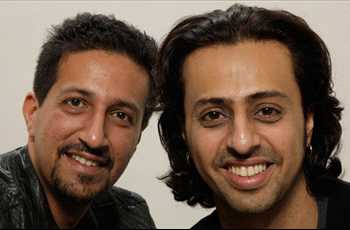
The Merchant Brothers
Salim & Sulaiman Merchant
Other than the connection with Fergie's dress, India had another presence at the FIFA World Cup Kick-off Celebration Concert as music duo Salim and Sulaiman Merchant performed the anthem which they had recorded for the 2010 FIFA World Cup, a feat that no Indian has had the honour of achieving ever before.
The two brothers, who are well known music directors in Bollywood with hits such as 'Chak De India', 'Iqbal', etc, performed along with notable South African singers Loyiso Vincent Bala and Kenyan Eric Waninaner at the Opening Concert of the 2010 World Cup and will do so again at the closing ceremony. Hopefully their music will inspire fans and players alike all over the globe.
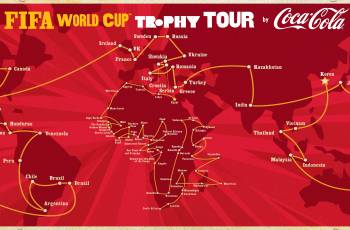
India Was Part Of The Tour
World cup Trophy Tour In Kolkata
Prior to South Africa 2010, the World Cup trophy was exhibited in 83 different countries during the official trophy tour. India was among the selected nations and the city of Kolkata had the honour of welcoming and showcasing the prized trophy. Originally the trophy was also supposed to come to the capital city of Delhi but later it was canceled.
Eventually the trophy came to the 'City of Joy' on 15th January 2010 with 1990 Germany World Cup winning captain Lothar Matthaus unveiling it and reminding memories of their triumph twenty years ago. This was for the first time that the original World Cup trophy came to India so it truly was a historic occasion and the people of Kolkata were privileged to witness the historic event.
Majid Bishkar & Emeka Ezuego
The I-League is dominated by the foreigners but none of them are household names in their own countries. Even before the National League started in 1996, a number of outstation footballers plied their trade in India but only two of them have the distinction of appearing in game's biggest stage.
Majid Bishkar was a squad member of Iran at the 1978 World Cup and three years later the attacking midfielder joined Kolkata giants East Bengal and made a real name for himself at the Kolkata Maidan.
Emeka Ezeugo, who was part of the Nigeria side that reached the knockout stage of the 1994 World Cup, had successful spells at Mohammedan Sporting and East Bengal towards the late 80's. The defender made a substitute appearance in a group game in the 94 edition of the World Cup against Bulgaria. He returned to India in 97 and spent one season at Churchill Brothers and eleven years later he had a short spell as coach of the Goan club.
2010 FIFA World Cup Terminologies
Vuvuzela
A vuvuzela, sometimes called a "lepatata" (its Setswana name) or a stadium horn, is approximately one metre in length, commonly blown by fans at football matches in South Africa. It is also used in Mexico, Brazil and Israel.
The origin of the name is disputed. It may originate from the Zulu for "making noise," from the "vuvu" sound it makes, or from township slang related to the word for "shower."
Originally made out of tin, the vuvuzela became popular in South Africa in the 1990s. They require some lip and lung strength to blow and emit a sound like a deep foghorn or an elephant.
Vuvuzelas have been controversial and have sometimes been banned from stadia. Critics say the instruments are blown haphazardly, which can be distracting to players and coaches who are trying to pay attention to the game.
A vuvuzela, sometimes called a "lepatata" (its Setswana name) or a stadium horn, is approximately one metre in length, commonly blown by fans at football matches in South Africa. It is also used in Mexico, Brazil and Israel.
The origin of the name is disputed. It may originate from the Zulu for "making noise," from the "vuvu" sound it makes, or from township slang related to the word for "shower."
Originally made out of tin, the vuvuzela became popular in South Africa in the 1990s. They require some lip and lung strength to blow and emit a sound like a deep foghorn or an elephant.
Vuvuzelas have been controversial and have sometimes been banned from stadia. Critics say the instruments are blown haphazardly, which can be distracting to players and coaches who are trying to pay attention to the game.
Diski
The South African World Cup dance, set to get the world jiving to an African rhythm. South Africa has a totally different way of playing soccer. It can be rhythmic, sometimes bordering on being showy, but certainly never boring.
Every move has a unique name, what is more, there is a different name for the same move, in different parts of the country. This is not surprising because South Africa has 11 official languages – including sign! Names include Chester and Tsamaya.
Makarapa
From a hard hat to one of South African football's most enduring icons, the history of the makarapa is as colourful as its inventor and the team colours they are decorated with. Along with the Vuvuzela, it has come to epitomise the vibrant spirit of South African football.
The Makarapa was originally made in 1979, for a match where two local teams were playing. For people in the cheap seats, fights often break out. A man who worked on a construction site, made himself a hard hat to protect himself against missiles.
Then he made it colourful, transforming it into a celebration of his team colours and logo. Soon, almost everyone wanted to wear a makarapa to matches.
Fans would often buy them right off his head. The man gave up his job, established a small workshop in his shack, and supplied a steady stream of customers with his unique creations.
From its humble beginnings with the original team colours of black and yellow, his magic touch has expanded to include a wide range of sports memorabilia.
Previous Emails on SamsoNGroup? :: Check here http://groups.google.com/group/samsongroup
or http://amazingpics1.blogspot.com/
""Don't be afraid to be amazing."
http://www.google.com/profiles/samson13.
Face it... Fight it
شمشون; SAMSON :-)
--
You received this message because you are subscribed to the Google Groups "Samsongroup" group.
To post to this group, send email to samsongroup@googlegroups.com.
To unsubscribe from this group, send email to samsongroup+unsubscribe@googlegroups.com.
For more options, visit this group at http://groups.google.com/group/samsongroup?hl=en.








0 comments:
Post a Comment